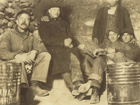
Gypsum Mines
GRHC - February 27th, 2011
Gypsum mines play a major role in Grand Rapids' early industry.
Transcript
Mention Grand Rapids and people think of furniture, but that was not our first important industry. It was gypsum, or plaster, discovered in extensive surface beds along the creek named for its discovery—Plaster Creek. The first mill for grinding the gypsum, built by Daniel Ball and Warren Granger, was located where Plaster Creek crossed the Grandville Road. By 1850 they were producing 60 tons daily.
The first gypsum quarry on the West Side of the Grand River was that of Richard Butterworth. The deposits there were not on the surface but many feet below layers of clay, limestone, and slate. At first gypsum was used extensively for fertilizer by farmers and only a minor portion for plaster and stucco. As population and building needs increased the proportions for farming and commercial use were reversed. Three other plaster mines were located south of John Ball Park, and plaster deposits actually run under the park itself.
In 1898 William T. Powers began constructing a gypsum mine one hundred feet beneath the Grand River. He owned land on the west bank, extending from the Sixth St. Bridge to where the Grand Rapids & Indiana Railroad crossed the river. At a depth of 60 feet a vein of plaster rock six feet in thickness was discovered. Immediately under this was an extremely fine quality of plaster rock twelve feet thick that runs under the river as far north as the Sixth St. Bridge. Plaster from this mine was shipped all over the world.
Full Details
| Title | Gypsum Mines |
|---|---|
| Creator | GRHC |
| Keywords | Glance at the Past, history, gypsum, mines, plaster, Grand Rapids, Historical Commission, radio, Podcast |
| Duration | 2:08 |
| Pubdate String | February 27th, 2011 |

 facebook
facebook